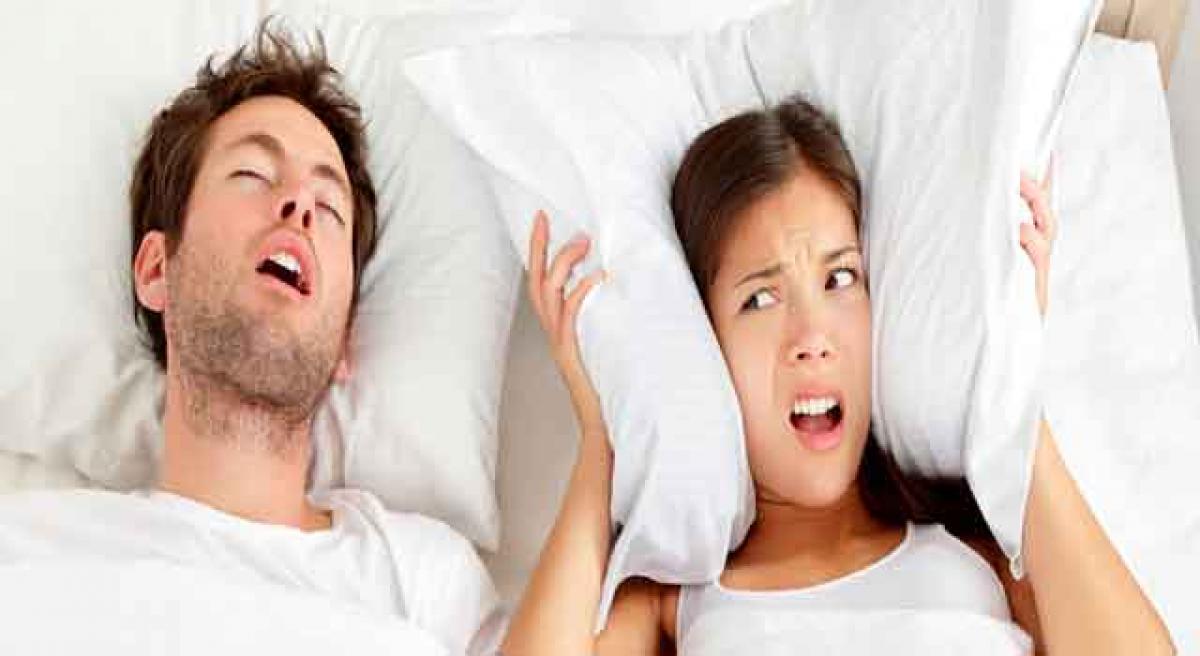Live
- UpStudy: The Smart Solution for Homework Hassles
- Actress Rithika and models inaugurate Sutraa Lifestyle Exhibition
- Loud campaign
- Faculty students celebrated english literature day in Government Degree College
- Huge fire accident.. Shops of street vendors burnt in the fire
- Pawan Kalyan promises to protect the coastal area from sea erosion
- EC Transfers Two Senior IPS Officers in AP ahead of Elections
- DMK analysis predicts victory for INDIA bloc in TN but concedes gains for BJP and NDA too
- India showcasing innovative technologies at World Energy Congress
- IPL 2024: Mitchell comes in for Ravindra as Lucknow opt to bowl first against Chennai
Just In

Snoring isn’t something that most of us worry about. In fact some of us even relate snoring to having a good night’s sleep. Around 40-45 per cent adults snore some or other time during sleep and they are unable to discern the difference between simple snoring and snoring as a disease. However, loud snoring when accompanied by daytime fatigue could be a sign of Obstructive Sleep Apnea.
Snoring isn’t something that most of us worry about. In fact some of us even relate snoring to having a good night’s sleep. Around 40-45 per cent adults snore some or other time during sleep and they are unable to discern the difference between simple snoring and snoring as a disease. However, loud snoring when accompanied by daytime fatigue could be a sign of Obstructive Sleep Apnea.
Obstructive Sleep Apnea is a common and potentially serious disorder in which breathing repeatedly stops and starts as you sleep. In sleep apnea breathing is briefly interrupted or becomes very shallow during sleep. These breathing pauses typically last between 10 to 20 seconds and can occur up to hundreds of times a night, jolting you out of your natural sleep rhythm.
As a result, the patient has a disturbed or fragmented sleep rather than a deep, restorative sleep that is required to be energetic, mentally sharp, and productive the next day. The most effective treatment prescribed is the use of the CPAP (Continuous Positive Airway Pressure) machine, which is a mask that covers your nose and mouth, providing a constant stream of air that keeps your breathing passages open while you sleep.
For those who have mild or moderate cases of sleep apnea, in addition to regularly using the CPAP machine, they can also do tongue and throat exercises to strengthen the muscles. There are several research studies published over the years that show the positive effect these exercises have on sleep apnea patients. The stronger muscles are less susceptible to collapsing during the sleep cycle.
Simple tongue and throat exercises you can try at home
- Press your tongue against the roof of the mouth, right behind the front teeth. Hold it there for five minutes - 2 times per day.
- Place your tongue between your teeth and swallow - 5 times per day.
- Purse your lips together. Hold them tight and then move them up and to the left ten times. Next, move them up and to the right 10 times.
- With your chin pointing down, place the tip of your tongue behind your top front teeth and slowly raise your chin towards the ceiling. Slide your tongue toward the back of your mouth, and then back to the front, keeping your chin pointed up the entire time (you should feel your neck muscles flexing). Repeat 10 times.
- Simulate a yawn and make sure to open your mouth as wide as you can. You can also thrust your tongue as far as it goes.
- Place your lips on a balloon. Take a deep breath through your nose then blow out through your mouth to inflate the balloon as much as possible. Repeat this five times without removing balloon from your mouth.
- Stick out your tongue, the farthest you can. Hold it for several seconds. Pull back, breathe and repeat.
- Run your tongue round the inside of your mouth, push it between your lips, up round the outside of your teeth, over the roof of your mouth and down on the base of your mouth. Do this exercise for 10 seconds.
- Say la lalala at an easy speed. Feel the tip of your tongue curl up to touch just behind your top teeth. Repeat this five times.
- Other strengthening exercises include chewing gum, gargling water for several minutes, clenching a pencil between the teeth, and belting out your favourite song.
Before starting any exercise routine you should consult with your doctor. It is important to note these exercises are not a substitute for using your CPAP machine and might only be true and helpful in cases of mild or moderate sleep apnea.
If done regularly, these natural aids can certainly help in keeping sleep apnea at bay and result in long term benefits. However, this might only be true and helpful in cases of mild or moderate sleep apnea.
By: Dr Srinivas Kishore

© 2024 Hyderabad Media House Limited/The Hans India. All rights reserved. Powered by hocalwire.com







